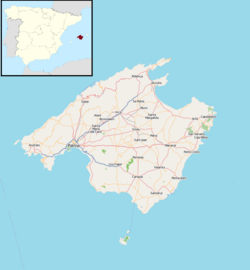Banyalbufar
| Banyalbufar | ||
|---|---|---|
| Municipality and town | ||
 |
||
|
||
| Location of the town in Majorca | ||
| Coordinates: 39°41′16″N 2°31′0″E / 39.68778°N 2.51667°E | ||
| Country |
|
|
| Autonomous Community | Balearic Islands | |
| Province | Balearic Islands | |
| Island | Majorca | |
| Comarca | Serra de Tramuntana | |
| Government | ||
| • Mayor (2007-) | Mateu Ferrà Bestard | |
| Area | ||
| • Total | 7.1 sq mi (18.5 km2) | |
| Elevation | 300 ft (100 m) | |
| Population (2012) | ||
| • Total | 517 | |
| • Density | 87/sq mi (33.5/km2) | |
| Time zone | CET (UTC+1) | |
| • Summer (DST) | CEST (UTC+2) | |
| Website | www.ajbanyalbufar.net | |
Banyalbufar is a municipality on the Spanish Balearic island of Majorca. The town of the same name is the administrative seat of the municipality. It borders the municipalities of Estellencs, Puigpunyent, Esporles, and Valldemossa.
The municipality of Banyalbufar has an area of 18.1 km² and lies next to the Serra de Tramuntana mountain off the C-710 along the road from Andratx to Valldemossa. The municipality also contains four smaller mountains, of which Mola de Planícia is the highest at 942 m, and Sa Talaia is the lowest at 309 m. Rainfall can occur all year round. The driest month is July with an average rainfall of 10.1 l/m². The heaviest rainfall is in October at 80.9 l/m². The heaviest rainfall in Banyalbufar occurred on 10 June 1975 at 170 l/m².
The original name Banyalbahar comprises two different components: banya and bahar. Banya derives from the name of a Moorish settlement established on the island in the 10th century. Bahar supposedly derives from the Catalan la mar or sa mar (meaning "the sea"), or from the Latin juxta mare (meaning "by the sea"). The original Moorish meaning of Banyalbufar is, therefore, "founded by the sea".
Following the Catalan conquest of Majorca in 1229, Banyalbufar came under control of Gilabert de Cruïlles and Ramon sa Clusa. During the Middle Ages and up until the 15th century, the valley was ruled under a practically absolutist government, the Barony of Banyalbufar. The baron maintained the civil and criminal jurisdiction over the entire population.
The inhabitants of Banyalbufar devoted themselves almost exclusively to agriculture. Fishing remained merely a secondary industry. Produce included wheat, barley, pulses, olives, flax, hemp, saffron and, above all, wine. The local Malvasier grape was highly prized. After a long period of decline, there are now efforts to revive this fruit. In previous times, the location was in reality a large vineyard. Around 2,000 steppes emanate from the peak of the location, which were once devoted exclusively to the production of Malvasier wine. The wine was highly favoured by the King of Aragon, and was in no small part a motive for the conquest by James I.
...
Wikipedia


